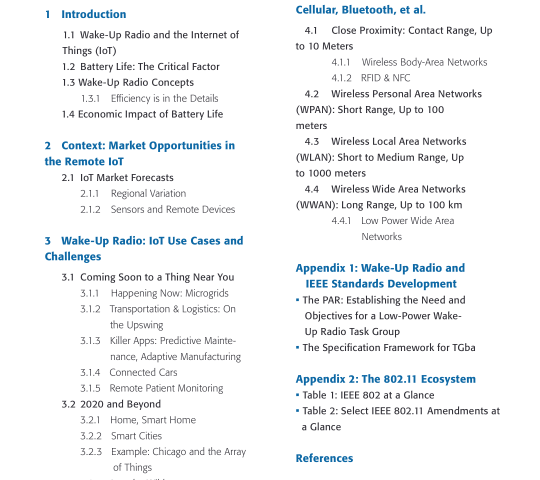IEEE 802.11BA-2017 pdf download.IEEE Technology Report on Wake-Up Radio: An Application, Market, and Technology Impact Analysis of Low-Power/Low-Latency 802.11 Wireless LAN Interfaces
1.2 Battery Life: The Critical Factor
Today’s smartphones usually have at least three main radios: the medium-range wireless local area network (WLAN or Wi-Fi), the longer range cellular radio, and the short-range Bluetooth personal area network. These may be joined by near feld communications and Global Positioning System radios, and accommodate an increasing number of legacy protocols for each radio (Figure 1-2).
The Wi-Fi, cellular, and Bluetooth protocols are also the three main candidates for connecting the Internet of Things—and each has strengths and weaknesses. Wi-Fi (IEEE Std 802.11™) fts seamlessly into the IEEE 802 ecosystem that includes Ethernet (IEEE Std 802.3™)—and between the two, carry the lion’s share of the world’s digital data and ofer straightforward integration with the Internet and web-based services. [See Appendix 2 for a table of the principle IEEE 802 working groups and a quick review of some IEEE 802.11 Wi-Fi amendments that have expanded the standard over the past two decades.]
Wi-Fi and Ethernet are designed to accommodate high-bandwidth data, such as streaming videos and fle sharing systems. Wi-Fi can operate through user-owned equipment and transmits on unlicensed radio frequencies. This makes it relatively easy and economical to set up wireless LANs. By the same token, setting up a Wi-Fi network can require some confguration. Until now, Wi-Fi has had a reputation for high power consumption, which has limited the service lives of remote devices in the feld. Low-Power Wake-Up Radio is aimed at provided a well-integrated power- conservation tool to remedy this shortcoming.
Cellular radios—including data-oriented 4G and 5G services—ofer long reach over licensed frequencies via commercially owned and maintained infrastructure. Cell service is highly reliable with low latency over wide areas, though users must generally use cell-system providers’ equipment and pay access fees.
Cellular communication remains focused on the base station: the cell tower. While there are proposals for supporting direct device-to-device communication on the edge, those standards are still being drafted and it is unclear whether and how this will be implemented. Bluetooth® ofers a short-distance, low-power connection. It was originally designed to connect cell phones with wireless peripherals like headsets, and has been oriented towards lower-bandwidth applications. Smartphone users know that leaving the phone’s screen and radios active can drain a battery in just a few hours.
For example, an iPhone 7 with a 1,960 milliamp-hour battery may deliver about 15 hours of 3G phone talk time, 12 hours of Internet browsing over an LTE cell connection, or 15 hours of Internet access over Wi-Fi. Short-range Bluetooth radios transmit at 1 to 2.5 milliwatts. Cellular and Wi-Fi radios generally broadcast at anywhere from 100 to a maximum of 1,000 milliwatts. But they clearly do not transmit constantly at full power; if they did, that 1,960 milliamp-hour battery would last no more than fve or six hours, even if the phone used no power for anything else.
Various amendments to the IEEE 802.11 standard (e.g., 802.11a, 802.11b, 802.11g, etc.) call for transmitting at lower power where appropriate (or where required by a complex web of regulatory and engineering requirements) at around 20 to 100 mW EIRP (equivalent isotropically radiated power, a fgure that takes the antenna’s signal boost into account). These are estimated fgures as actual power usage can vary in response to the details of the protocol and environmental conditions.
There are always trade-ofs when trying to conserve power. Lower-power transmissions, for example, may also reduce the signal-to-noise ratio—lowering data rates and necessitating longer transmissions. Longer transmission times require more power, negating some of the apparent economy of switching to lower power. Duty-cycling is a frequent solution for power conservation.
The radio turns of and goes to sleep when not in use, waking up for just a few milliseconds at intervals from a tenth of a second to an hour, to see if anybody is trying to get through. Early in the LP-WUR process, TGba Chair Minyoung Park calculated that running a Wi-Fi radio at a 2% duty cycle in “legacy power saving mode”—having it wake up for 2 milliseconds out of every 100— should reduce average idling power drain from about 100 mW to about 1.6 mW [4]. This would stretch the idling time of a 130 mAh battery life from a few hours to about three days. The exact power saving depends on a variety of factors; this example illustrates the general kinds of improvement LP-WUR should produce, rather than predicting specifc performance.IEEE 802.11BA pdf download.IEEE 802.11BA-2017 pdf download
IEEE 802.11BA-2017 pdf download

Leave a Reply